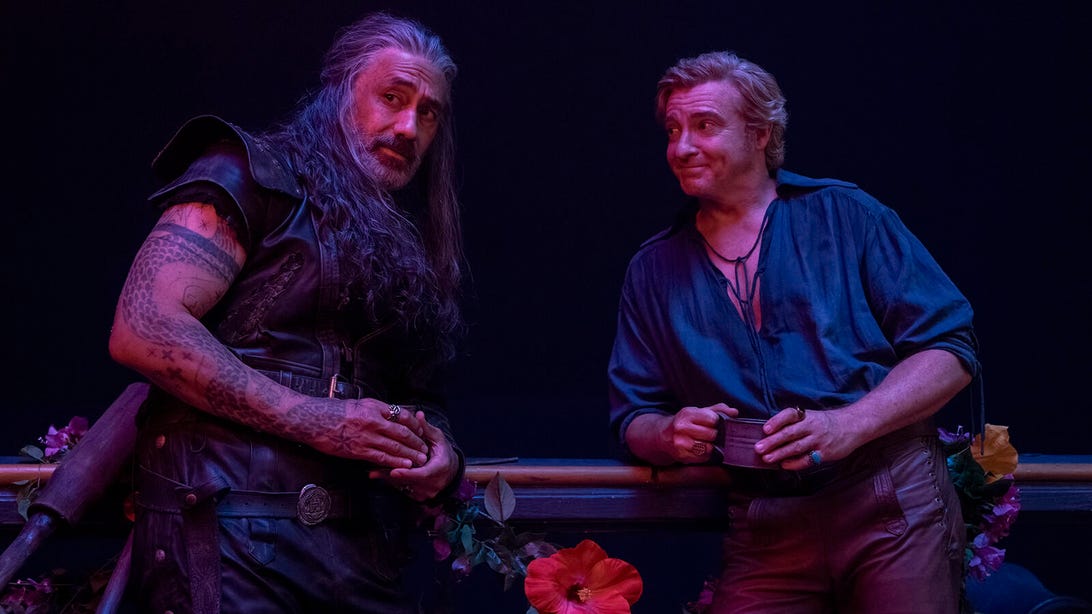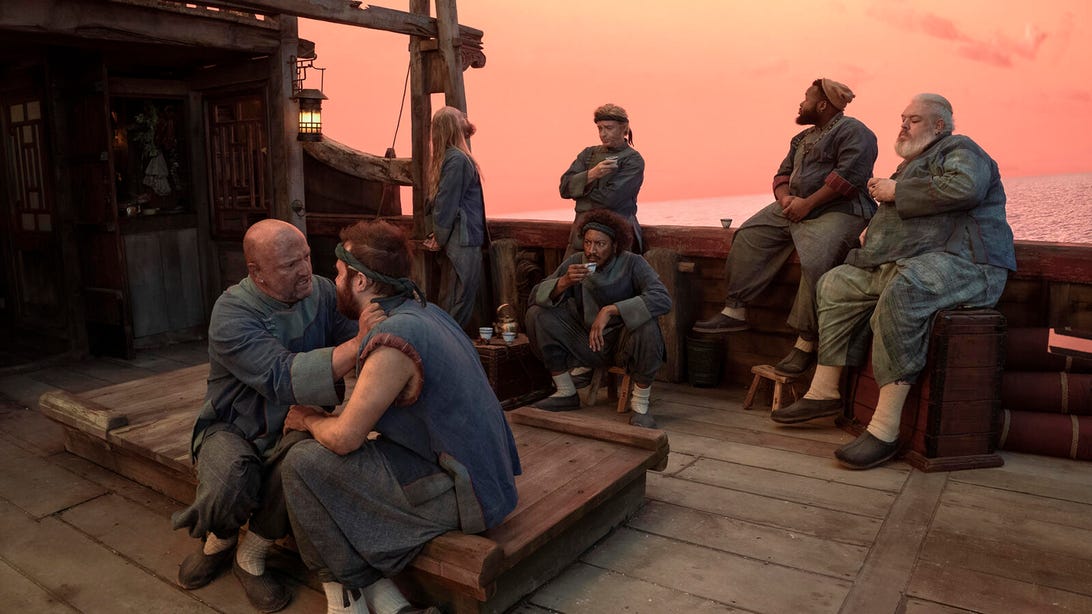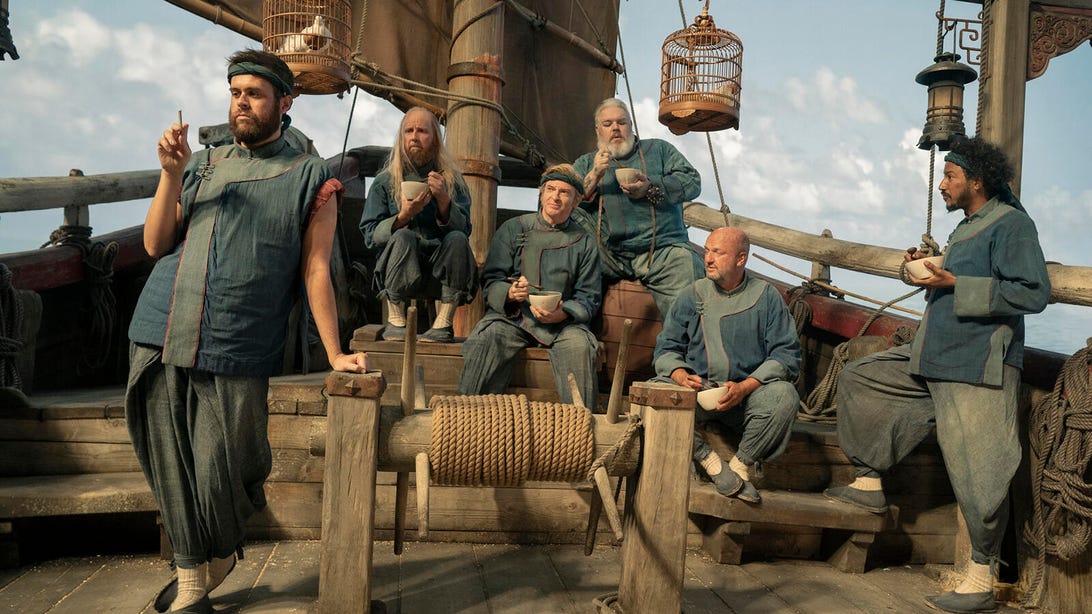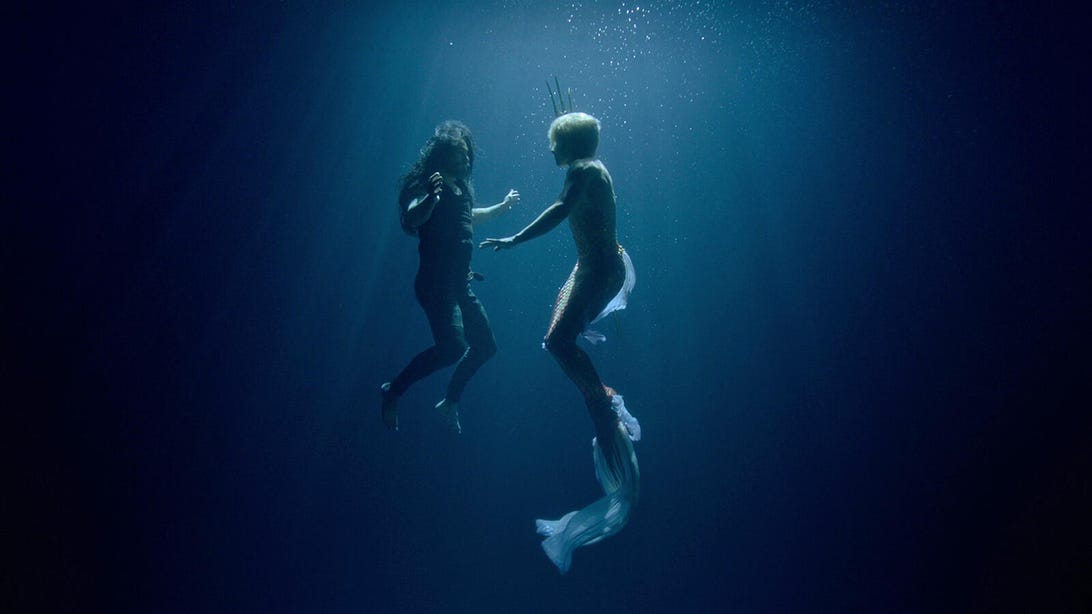Join or Sign In
Sign in to customize your TV listings
By joining TV Guide, you agree to our Terms of Use and acknowledge the data practices in our Privacy Policy.
In Praise of Our Flag Means Death's Visibly Fake Special Effects
The pirate sitcom thrives by embracing a flexible approach to realism

Taika Waititi and Rhys Darby, Our Flag Means Death
Nicola Dove/MaxOur Flag Means Death is the antidote to gritty realism. Its most believable detail is Taika Waititi's wig — an impressive feat, considering the plague of inflexible Barbie lace-fronts we see in shows like House of the Dragon. Coupled with Waititi's Mad Max biker costume, that glorious wig reflects the aesthetic priorities of the show's creators. They want Our Flag Means Death to look good, but their definition of "good" is different from what we see elsewhere — especially when it comes to historical accuracy.
In fact, OFMD's great unsung victory is the way it adjusts its visual language to fit such a dizzying range of tones. Some scenes are dramatic and grounded, featuring sweeping landscapes and intense performances. Others rely on Looney Tunes cartoon logic. The show exists on a sliding scale of realism, echoing the surreal detours and cheerfully phony studio sets of classic movie-musicals like Singin' in the Rain. Case in point: Blackbeard's (Waititi) merman fantasy, an effects-heavy sequence involving a prosthetic tail and a complicated underwater shoot.
Unlike most sitcoms, Our Flag Means Death combines location shooting with elaborate studio sets, stunt sequences, and extensive visual effects. For obvious practical reasons, filming at sea was a no-go. These pirate ships set sail indoors, in dry soundstages surrounded by LED screens depicting a facsimile of outdoor scenery. It's an updated version of old-school painted backdrops, perfect for OFMD's theatrical tone.

Our Flag Means Death
Nicola Dove/MaxKnown as the Volume, this LED technology was spearheaded by Disney's live-action Star Wars shows. In some ways it's a major improvement on green screen filming. Displaying detailed, animated imagery, these wraparound screens create a more immersive environment than the featureless green soundstages used for blockbusters like the Avengers franchise. Filmmakers can also adjust the scenery in real time, instead of waiting to see how things look in post-production.
But despite the hype from actors and studios, the Volume has already developed a negative reputation among viewers. Shows like Obi-Wan Kenobi and The Mandalorian faced criticism for their hollow production values and flat lighting, earning harsh comparisons to the tangible grime of classic Star Wars. It turns out that photorealistic CGI backdrops are not, in fact, a workable replacement for location shoots or traditional production design.
Our Flag Means Death is one of the Volume's few success stories, and while the show's creative team love to praise the realism of those seafaring backdrops, I actually hold a different view. Our Flag Means Death works because it doesn't look real.
Much of the time, OFMD's Volume scenery is designed to fade into the background. Created using footage of New Zealand coastlines, those backdrops primarily exist to remind viewers that the show takes place at sea. The foreground is more attention-grabbing — and more stylized, whether it's the anachronistic costumes or the charmingly theatrical sets. If those elements were any more grounded in reality, then Stede (Rhys Darby) and Blackbeard's exaggerated melodrama would feel rather out of place.

Our Flag Means Death
Nicola Dove/MaxInstead of resembling the carefully researched ships of something like Master and Commander, the Revenge's deck is a wide, uncluttered stage that rarely moves unless it's caught in a storm. In a relationship-driven sitcom, there's no need to literally rock the boat. Storms exist purely for emotional punctuation, with weather and scenery acting as a kind of mood ring. So when Blackbeard hits rock bottom, his ship becomes a dark, roiling embodiment of inner torment, dousing the deck with gouts of seawater. At other times, water is irrelevant to any "sailing" that allegedly takes place in this show.
These emotive scenes are when OFMD's use of the Volume really stands out, suggesting a different philosophy from that of the shows and movies that use it as a catch-all replacement for location filming. In OFMD, it's one of many visual tools that bolsters the larger-than-life tone. For instance, during Lucius (Nathan Foad) and Pete's (Matthew Maher) reunion this season, the LED backdrops display a luminously sentimental peach-pink sunset. And on several occasions the show makes judicious use of a CGI moon, carefully placed above Stede and Blackbeard's heads during romantic moments. How big is the moon in Our Flag Means Death? As big and as close as it needs to be. A real moon just wouldn't work as well.
Many of the show's most striking visual moments work along similar lines, prioritizing atmosphere over realism — a mindset that rejects mainstream attitudes to visual effects.
According to popular opinion, the best effects are indistinguishable from reality. The scene where Blackbeard plunges off a cliff is a perfect example. Despite being a CG composite shot, it looks utterly convincing. But the show also includes numerous scenes where characters stand upright in comedically immovable fake rowing boats, or stride along tourist paths in "jungles" that were clearly filmed in some kind of public garden.
These moments of visual unreality are crucial to a world where characters routinely shrug off life-threatening wounds, process emotional upheaval through 1980s power ballads, or sail halfway across the Caribbean in a single episode. To use Blackbeard's own terminology, Our Flag Means Death thrives on f---ery.

Taika Waititi and Rhys Darby, Our Flag Means Death
MaxIn the midst of public pushback against rushed, low-quality blockbuster CGI, Our Flag Means Death demonstrates a different route. Aesthetically and thematically, it embraces a flexible attitude to tone and genre. It's also emphatically fictional, encouraging viewers to ignore logic and accept a world of vibes-based storytelling. And it works! It's just a lot more complicated than it seems.
Earlier this year, Disney's Little Mermaid remake proved once again that money can't buy taste, sabotaging some likable performances with Uncanny Valley CGI. OFMD's brief mermaid sequence looks better, but it doesn't necessarily look less fake. It's just a different kind of fake, in a context where it simply doesn't matter if we can see Rhys Darby's legs under his mermaid tail. The important thing is the poignancy and symbolism of the scene, inviting us to think about Blackbeard's relationship with the ocean, his image of Stede as a savior, and the contrast between Stede's own dream sequence (depicting himself as a swashbuckling hero) and Blackbeard's softer, less masculine image of their reunion.
Tellingly, the mermaid scene culminates with Blackbeard escaping the visually grounded world of Purgatory — a sequence filmed on the New Zealand coast — and waking on board the Revenge, a set with a noticeably Muppet Treasure Island aesthetic. It's a clear reminder that Our Flag Means Death's theatrical side is a feature, not a bug — and that reality is in the eye of the beholder.
New episodes of Our Flag Means Death Season 2 stream Thursdays on Max.